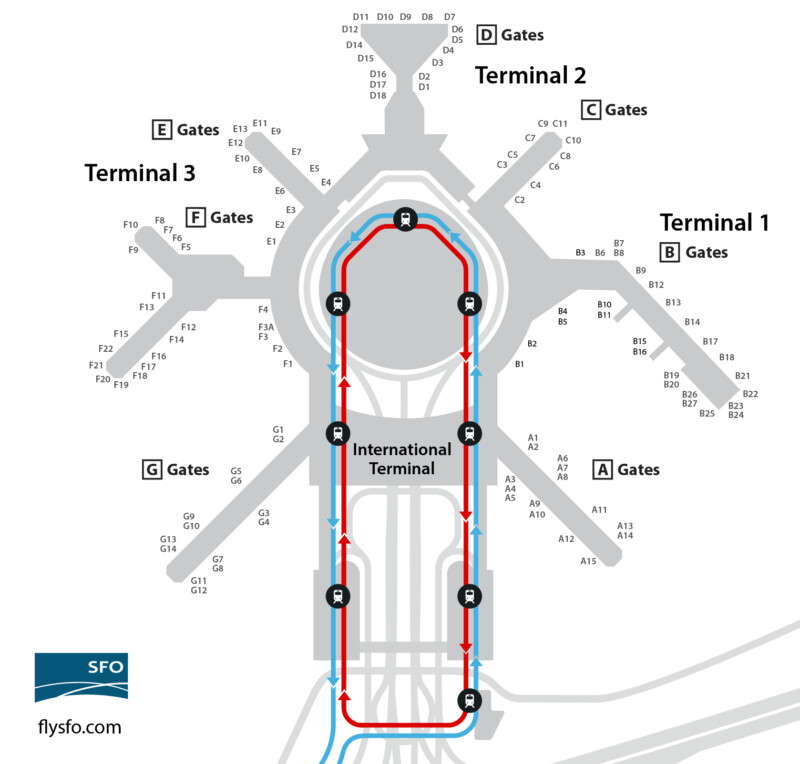
SFO Terminal Complex location on Google Maps
About 13 miles south of the city, San Francisco International Airport is off U.S. Highway 101, the Bayshore Freeway, on the bay side of the peninsula in San Mateo County. From the airport, San Francisco’s downtown Financial District is about 40 minutes drive time in normal traffic.

To picture the layout of San Francisco airport’s passenger terminals, think of a bolo tie (or any necktie for that matter) where the cord is a two-level roadway with departures on the upper level and arrivals on the lower level. The International Terminal straddles the roadway like the sliding clasp (or knot) and three domestic terminals are located on the loop that goes around the neck (in this case the roadway “loop” goes around parking garages). Seven concourses, called piers at this airport, radiate out from the terminals. Construction is making it possible for passengers to make connections between terminals without exiting security. The only connector that is not completed is between the B gates in Terminal 1 and the C gates in Terminal 2, which is due to open in Spring 2024.
Domestic Terminals and airlines (in order along the roadway):
International Terminal
AirTrain, a free automated people mover, operates two lines around the airport, both of which connect all terminals, the terminal parking garages, the Bay Area Rapid Transit (BART) station and the Grand Hyatt at SFO hotel. The Red Line travels clockwise through the terminal area. The Blue line travels counter-clockwise and also serves the Rental Car Center. Trains operate about every 4 minutes. To reach the AirTrain stations from terminals 1, 2 and 3, take an elevator or escalator to Mezzanine-Level 3 and cross the passenger skybridge and from the International Terminal take an elevator or escalator to Level 4. Passengers must exit the TSA secure area to use AirTrain.
Ground transportation options include taxis, reserved car services and shuttles, which can be met outside baggage claim curbside at the center islands. The pick-up area for app-based rides is Level 5 of the Parking Garage for terminals 1, 2 and 3 or curbside outside baggage claim at the International Terminal. Bay Area Rapid Transit (BART) trains depart SFO from a station at the International Terminal. Passengers arriving at other terminals can use the AirTrain to connect to the BART station. Trains depart SFO about every 15 minutes and have a scheduled travel time of 30 minutes to downtown San Francisco.
United Airlines domestic flights arrive and depart SFO at gates E1-E13 and F1-F22 in Terminal 3 and some use the D gates in Terminal 2. United’s international flights use gates G1-G14 in the International Terminal. Passengers can connect to all United gates without exiting the TSA secure area. There are also post-security connectors beyond the International Terminal to Terminal 1 and from Terminal 3 to Terminal 2. (A connector between terminals 1 and 2 is under construction.)
The heart of the Bay Area, San Francisco is America’s uniquely cosmopolitan city. Home to the iconic Golden Gate Bridge, cable cars, Fisherman’s Wharf an, Alcatraz, the city is also famous for its neighborhoods, including the eclectic Castro and North Beach and historic Chinatown and Mission District as well as the gleaming structures being built by booming tech industries.
Learn more from the San Francisco Travel Association

The color change came after construction started in 1933 when consulting architect Irving Morrow noticed the reddish-orange primer on the arriving steel. The San Francisco Bay’s notorious fog had already become an issue and, in fact, the Navy had begun lobbying for yellow horizontal stripes to be painted on the otherwise black-colored bridge to make it more visible. Morrow launched a successful two-year campaign that included a 29-page report on why the bridge should be painted more like the primer, saying it would stand out in the fog and complement the landscape, sky and water. The color is officially named Golden Gate Bridge International Orange, which is slightly lighter than standard international orange.
Be among the first to know and get regular updates about Tucson International Airport from the Tucson Airport Authority in our monthly newsletter.